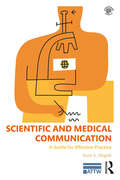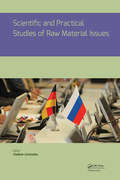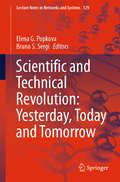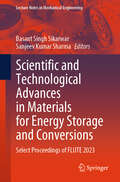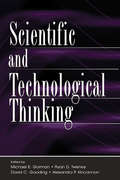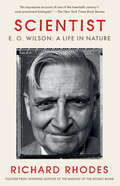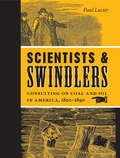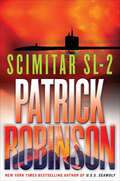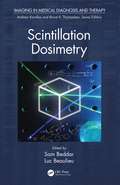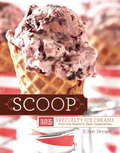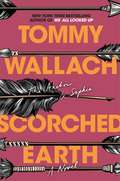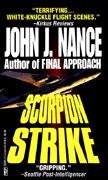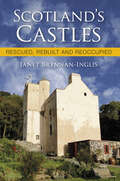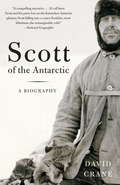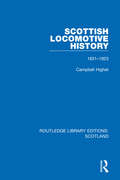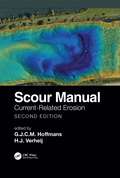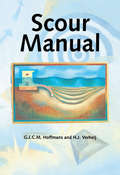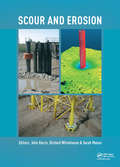- Table View
- List View
Scientific and Medical Communication: A Guide for Effective Practice (ATTW Series in Technical and Professional Communication)
by Scott A. MogullScientific and Medical Communication: A Guide for Effective Practice prepares readers to effectively communicate in professional scientific communities. The material in this book is firmly grounded in more than 500 published research findings and editorials by scientific writers, authors, and journal editors. Thus, this text provides the broadest and most comprehensive analysis of scientific writing. In addition, carefully selected and thoroughly annotated examples from the scientific and medical literature demonstrate the recommendations covered in the text. These real-world examples were carefully selected so that the scientific content can be understood by those without a detailed background in any particular scientific or medical field—thus clearly illustrating the content organization and writing style. This text will prepare individuals to write and edit scientific manuscripts, conference abstracts, posters, and press releases according to journal and professional standards. Readers will also learn to conduct effective searches of the scientific and medical literature, as well as proper citation practices.
Scientific and Practical Studies of Raw Material Issues
by Vladimir Litvinenko Lucy RichardsScientific and practical studies of raw material issues presents the contribution to the Russian-German raw materials forum. The main theme of the book is problematic issues of subsoil use, whereby the contributions are divided in two main parts: - Exploration, mining and processing, and - Mining services Paying much attention to complex processes in the mining industry, Scientific and practical studies of raw material issues will be of interest to academics and professional involved or interested in Mining Engineering and Earth Sciences.
Scientific and Technical Revolution: Yesterday, Today and Tomorrow (Lecture Notes in Networks and Systems #129)
by Elena G. Popkova Bruno S. SergiThis book presents a system view of the digital scientific and technological revolution, including its genesis and prerequisites, current trends, as well as current and potential issues and future prospects. It gathers selected research papers presented at the 12th International Scientific and Practical Conference, organized by the Institute of Scientific Communications. The conference “Artificial Intelligence: Anthropogenic Nature vs. Social Origin” took place on December 5–7, 2019 in Krasnoyarsk, Russia. The book is intended for academic researchers and independent experts studying the social and human aspects of the Fourth Industrial Revolution and the associated transition to the digital economy and Industry 4.0, as well as the creators of the legal framework for this process and its participants – entrepreneurs, managers, employees and consumers. It covers a variety of topics, including “intelligent” technologies and artificial intelligence, the digital economy, the social environment of the Fourth Industrial Revolution and its consequences for humans, the regulatory framework of the Fourth Industrial Revolution, and the “green” consequences, prospects and financing of the Fourth Industrial Revolution.
Scientific and Technological Advances in Materials for Energy Storage and Conversions: Select Proceedings of FLUTE 2023 (Lecture Notes in Mechanical Engineering)
by Basant Singh Sikarwar Sanjeev Kumar SharmaThis book presents the select proceedings of 2nd Biennial International Symposium on “Fluids and Thermal Engineering” (FLUTE 2023). It covers the Scientific and Technological Advances in the field of materials and their devices for advanced energy storage and relevant energy conversion. Various topics covered in this book are sustainable energy conversion and storage technologies, renewable energy, water desalination, rechargeable batteries: metal–ion, metal–air, and redox flow batteries, emerging materials for energy storage, energy conversion devices, chemical energy storage, thermoelectric and thermos electrochemical cells, and many more. The book is useful for researchers and practitioners in the industry and academia.
Scientific and Technological Thinking
by Michael E. Gorman Ryan D. Tweney David C. Gooding Alexandra P. KincannonAt the turn of the 21st century, the most valuable commodity in society is knowledge--particularly new knowledge that may give a culture, company, or laboratory an adaptive advantage. Knowledge about the cognitive processes that lead to discovery and invention can enhance the probability of making valuable new discoveries and inventions. Such knowledge needs to be made widely available to ensure that no particular interest group "corners the market" on techno-scientific creativity. Knowledge can also facilitate the development of business strategies and social policies based on a genuine understanding of the creative process. Furthermore, through an understanding of principles underlying the cognitive processes related to discovery, educators can utilize these principles to teach students effective problem-solving strategies as part of their education as future scientists.This book takes the reader out onto the cutting edge of research in scientific and technological thinking. The editors advocate a multiple-method approach; chapters include detailed case studies of contemporary and historical practices, experiments, computational simulations, and innovative theoretical analyses. The editors attempt a provocative synthesis of this work at the end.In order to achieve true scientific and technological progress, an understanding of the process by which species are transforming the world is needed. This book makes an important step in that direction by leading to breakthroughs in the understanding of discovery and invention.
Scientist: E. O. Wilson: A Life in Nature
by Richard RhodesA masterful, timely, fully authorized biography of the great and hugely influential biologist and naturalist E. O. Wilson, one of the most ground-breaking and controversial scientists of our time—from the Pulitzer Prize-winning author of The Making of the Atomic Bomb &“An impressive account of one of the 20th century&’s most prominent biologists, for whom the natural world is &‘a sanctuary and a realm of boundless adventure; the fewer the people in it, the better.&’&” —The New York Times Book ReviewFew biologists in the long history of that science have been as productive, as ground-breaking and as controversial as the Alabama-born Edward Osborne Wilson. At 91 years of age he may be the most eminent American scientist in any field.Fascinated from an early age by the natural world in general and ants in particular, his field work on them and on all social insects has vastly expanded our knowledge of their many species and fascinating ways of being. This work led to his 1975 book Sociobiology, which created an intellectual firestorm from his contention that all animal behavior, including that of humans, is governed by the laws of evolution and genetics. Subsequently Wilson has become a leading voice on the crucial importance to all life of biodiversity and has worked tirelessly to synthesize the fields of science and the humanities in a fruitful way.Richard Rhodes is himself a towering figure in the field of science writing and he has had complete and unfettered access to Wilson, his associates, and his papers in writing this book. The result is one of the most accomplished and anticipated and urgently needed scientific biographies in years.
Scientists Must Write: A Guide to Better Writing for Scientists, Engineers and Students
by Robert BarrassGood writing and communication skills are essential in many areas of science and engineering, to help observation, thinking and remembering, to organize work and to avoid stress. Written by a scientist for scientists, this book is much more than a textbook of English grammar – it is a valuable source of information for all aspects of writing in scientific and technical situations. The only book focusing on the ways in which writing is important to the scientific community, this book assists readers on: * how to write and choice of words* using numbers and illustrations* writing project reports, theses and papers for publication* giving a short talk or presentation. The new edition of Scientists Must Write has been fully revised and updated to take account of the changes in information and communications technology including word processing and information storage and retrieval; new appendices on punctuation, spelling and computers; and useful exercises to improve writing. This popular guide will be of great use to undergraduates, postgraduates, professional scientists and engineers.
Scientists Who Changed History (DK People Who Changed History)
by DKExplore the lives and achievements of more than 85 of the world's most inspirational and influential scientists with this innovative and boldly graphic biography-led book.The second title in DK's new illustrated biography series, Scientists Who Changed History profiles trailblazing individuals from Greek mathematicians, such as Archimedes and Hipparchus, through physicists of the early 20th-century, such as Marie Curie and Albert Einstein, to modern greats such as Stephen Hawking and Tim Berners-Lee. Each featured individual has made a major contribution to one or more scientific fields, from astronomy, biology, and psychology, to computer science and geology.Combining elements of biography, history, and analysis, Scientists Who Changed History explains the groundbreaking contributions made by these revolutionary men and women in a clear and informative way.
Scientists and Swindlers: Consulting on Coal and Oil in America, 1820–1890 (Johns Hopkins Studies in the History of Technology)
by Paul LucierIn this impressively researched and highly original work, Paul Lucier explains how science became an integral part of American technology and industry in the nineteenth century. Scientists and Swindlers introduces us to a new service of professionals: the consulting scientists. Lucier follows these entrepreneurial men of science on their wide-ranging commercial engagements from the shores of Nova Scotia to the coast of California and shows how their innovative work fueled the rapid growth of the American coal and oil industries and the rise of American geology and chemistry. Along the way, he explores the decisive battles over expertise and authority, the high-stakes court cases over patenting research, the intriguing and often humorous exploits of swindlers, and the profound ethical challenges of doing science for money.Starting with the small surveying businesses of the 1830s and reaching to the origins of applied science in the 1880s, Lucier recounts the complex and curious relations that evolved as geologists, chemists, capitalists, and politicians worked to establish scientific research as a legitimate, regularly compensated, and respected enterprise. This sweeping narrative enriches our understanding of how the rocks beneath our feet became invaluable resources for science, technology, and industry.
Scientists and Swindlers: Consulting on Coal and Oil in America, 1820–1890 (Johns Hopkins Studies in the History of Technology)
by Paul LucierAn “insightful” account of the early fossil fuel industry, the rise of the professional consultant, and the nexus between science and money (Technology and Culture).In this impressively researched, highly original work, Paul Lucier explains how science became an integral part of American technology and industry in the nineteenth century. Scientists and Swindlers introduces us to a new service of professionals: the consulting scientists. Lucier follows these entrepreneurial men of science on their wide-ranging commercial engagements from the shores of Nova Scotia to the coast of California and shows how their innovative work fueled the rapid growth of the American coal and oil industries and the rise of American geology and chemistry. Along the way, he explores the decisive battles over expertise and authority, the high-stakes court cases over patenting research, the intriguing and often humorous exploits of swindlers, and the profound ethical challenges of doing science for money. Starting with the small surveying businesses of the 1830s and reaching to the origins of applied science in the 1880s, Lucier recounts the complex and curious relations that evolved as geologists, chemists, capitalists, and politicians worked to establish scientific research as a legitimate, regularly compensated, and respected enterprise. This sweeping narrative enriches our understanding of how the rocks beneath our feet became invaluable resources for science, technology, and industry.
Scimitar SL-2 (Arnold Morgan #7)
by Patrick RobinsonTerrorists aim to create a mega-tsunami with a nuclear missile in this military thriller by the New York Times–bestselling author of Barracuda 945.Amid the Canary Islands lies the massive crater of the volcano Cumbre Vieja. Scientists theorize that one day the volcano will erupt, triggering a series of events that will lead to a tsunami higher than any in recorded history. This mega-tsunami, with waves of more than 150 feet in height, would ravage Europe, Africa, and ultimately the East Coast of the United States, causing immeasurable loss of life and destruction . . . After Professor Paul Landon, the world’s most prominent geophysicist, is found with a bullet in his head, it is discovered that Ravi Rashood—America’s nemesis and the former SAS officer who is now the head of Hamas—has hatched a diabolical plot against the West: to fire a nuclear-tipped guided cruise missile—Scimitar SL-2, named for the curved sword of the Muslim warrior Saladin—into Cumbre Vieja.U.S. Admiral Arnold Morgan, the retired National Security Adviser, and the Pentagon know it’s not a joke when Rashood, accompanied once again by his wife, the Palestinian Shakira, explodes Mount St. Helens. Morgan knows something even more horrific is to come. But stopping them won’t be easy.Rashood and his Hamas crew are deep in the ocean, in an undetectable sub, which he managed to procure from Russia via communist China. Perhaps worse, a new president, a weak-willed liberal in the White House, worries about taking a stand. As the terrorists’ deadline approaches, the newly implemented and unseasoned National Security team must consider the unthinkable. They must assume the daunting task of organizing a mass relocation of major population centers along the East Coast to safer ground.Morgan once again finds himself at the center of a desperate cat-and-mouse chase, battling his greatest enemy yet as he races against time to locate the silent underwater marauder and stop Rashood before the unimaginable happens . . . With his trademark authentic research and grasp of military hardware, geopolitics, and cutting-edge science, Patrick Robinson is at the top of his game with this tale.Praise for Scimitar S-2“What Robinson does do . . . is tell a great story, and tell it well, and scare the living vinegar out of you along the way. . . . Scimitar S-2may well be the most frightening book you will read all year.” —Bookreporter.com
Scintillation Dosimetry (Imaging in Medical Diagnosis and Therapy)
by Sam Beddar Luc BeaulieuScintillation Dosimetry delivers a comprehensive introduction to plastic scintillation dosimetry, covering everything from basic radiation dosimetry concepts to plastic scintillating fiber optics. Comprised of chapters authored by leading experts in the medical physics community, the book: Discusses a broad range of technical implementations, from point source dosimetry scaling to 3D-volumetric and 4D-scintillation dosimetry Addresses a wide scope of clinical applications, from machine quality assurance to small-field and in vivo dosimetry Examines related optical techniques, such as optically stimulated luminescence (OSL) or Čerenkov luminescence Thus, Scintillation Dosimetry provides an authoritative reference for detailed, state-of-the-art information on plastic scintillation dosimetry and its use in the field of radiation dosimetry.
Scoop: 125 Specialty Ice Creams from the Nation's Best Creameries
by Ellen BrownSummertime's here, and 'tis the season for making ice cream at home for parties, backyard barbecues, and beach getaways. A guide to more than two dozen of the nation's best artisan dairies, Scoop takes you on a colorful tour with photos, stories, and histories of these mom-and-pop shops. Author Ellen Brown has reinterpreted classic frozen recipes for the home cook, each fitted to the most popular ice cream freezers on the market. Explore the nation's favorite ice cream shops with a plethora of delectable photographs and 150 recipes--featuring ice cream, gelato, sorbet, and more. This is the must-have guide for the at-home ice cream connoisseur.
Scorched Earth (The Anchor & Sophia #3)
by Tommy WallachFrom the New York Times bestselling author of We All Looked Up comes the exciting conclusion to the &“haunting…beautiful and heartbreaking&” (School Library Journal) Anchor & Sophia trilogy, where the rules of humanity come to a head in the final battle between two warring cities.In this thrilling conclusion to the Anchor & Sophia trilogy, the great war has finally begun. The Descendancy must fight for its survival against not only the Sophian army, but a Wesah nation newly galvanized by the Black Wagon Massacre. And four young people will once again find themselves at the center of the maelstrom. Accused of a crime she didn&’t commit, Paz Dedios is on the run from the law...and the man she loves. Traumatized by the near-genocide of her people and the death of her lover, Athène is bent on revenge. Newly reunited in the Anchor, Clive and Clover Hamill will struggle to come to terms with the reappearance of a ghost from the past. Who will win the war for the future? And who will be left standing when it&’s all over?
Scorpion Strike
by John J. NanceTHE GULF WAR IS OVER. BUT A DEADLIER WAR IS ABOUT TO ERUPT.... In the wake of Operation Desert Storm, a defecting Iraqi scientist has revealed Saddam Hussein's horrifying plans for a devastating counterstrike against his enemies... and the world. With no time to spare, American forces must remobilize to locate and neutralize the underground laboratory where a lethal super-virus is ready to be unleashed. But an eleventh-hour disaster thrusts the entire mission into the hands of Air Force comrades-in-arms Colonel Will Westerman and Reserve Colonel-turned-commercial pilot Doug Harris. Flying into the heart of Iraqi power, they must depend on their skills-and each other-as never before, to complete a mission that looks more and more like a suicide run....
Scorpion Strike
by John J. NanceTwo air force pilots race to stop an Iraqi bioweapon in this thriller filled with &“white-knuckle flight scenes&” from a New York Times–bestselling author (Kirkus Reviews). A scientist charged by Saddam Hussein with pioneering a horrific breakthrough in biological warfare, Shakir Abbas defects at the American embassy to warn the world of the new weapon. America&’s worst nightmare has come true—and now US forces must scramble to put together a plan to destroy the weapon of mass destruction. When the operation goes awry in Saudi Arabia, Col. Will Westerman commandeers a C-141 transport to get the Special Forces team into Iraq. With the help of air force buddy Col. Doug Harris, Westerman reaches his target only to discover that the unthinkable has happened. Now they must use all their ingenuity, daring, and adrenaline to stop a worldwide catastrophe—and survive what looks increasingly like a suicide mission. From the bestselling author of Pandora&’s Clock and the Kat Bronsky series—a pilot and Operation Desert Storm veteran himself—this is a &“gripping&” aviation thriller (Seattle Post-Intelligencer) featuring &“thoroughly realistic background detail and an entirely too plausible plot&” (Kirkus Reviews).
Scorpion: A Novel
by Christian Cantrell&“An exceptional, fast-paced thriller featuring a tech-empowered assassin whose pattern and objective you&’ve never seen before, chased by a heroine with tenacious grit.&”—David Brin, author of The Postman and ExistenceQuinn Mitchell is a nine-to-five spy—an intelligence analyst for the CIA during the day, and a suburban wife and mother on evenings and weekends. After her young daughter is killed in a tragic accident, sending her life into a tailspin, Quinn hopes to find a new start in her latest assignment: investigating a series of bizarre international assassinations whose victims have been found with numeric codes tattooed, burned, or carved into their flesh. As Quinn follows the killer&’s trail across the globe, always one body behind, she begins uncovering disturbing connections between the murders—and herself. Every lead she tracks down in pursuit of the assassin brings Quinn one step closer to the Epoch Index, a mysterious encrypted message discovered in the archives of the Large Hadron Collider. Its origins are unknown and decrypting it is beyond even the CIA. Yet nothing else can possibly link together a slew of unsolvable murders, an enigmatic and sophisticated serial killer who always seems to be three steps ahead, a quirky young physics prodigy whose knowledge extends well beyond her years, and, underlying everything, the inescapable tragedy of Quinn&’s own past. Discovering the meaning of the Epoch Index leads Quinn to a shocking twist that shatters everything she thought she knew about the past, the future, and the delicate balance of right and wrong that she must now fight to preserve.
Scotland's Castles: Rescued, Rebuilt and Reoccupied
by Janet Brennan-InglisScotland’s Castles is a beautifully illustrated celebration and account of the renaissance of Scottish castles that has taken place since 1950. Over 100 ruined and derelict buildings – from tiny towers to rambling baronial mansions – have been restored as homes, hotels and holiday lets. These restorations have mainly been carried out by new owners without any connections to the land or the family history of the buildings, which they bought as ruins. Their struggles and triumphs, including interviews and first-person accounts, form the core of the book, set in the context of the enormous social, political and economic changes of the late twentieth century.
Scott of the Antarctic: A Biography
by David CraneHistorian David Crane, with full access to the explorer's papers, diaries, and expedition records, gives us an illuminating portrait of Robert Falcon Scott that is more nuanced and balanced than any we have had before. In reassessing Scott's life, Crane is able to provide a fresh perspective on not only the Discovery expedition of 1901-4 and the Terra Nova expedition of 1910-13, but his remarkable scientific achievements and the challenges of his tumultuous private life. Neither foolhardy dilettante, nor the last romantic champion of his age, Scott is presented as a man of indomitable courage and questionable judgment. The result is an absolutely compelling portrait of a complicated hero.
Scottish Building Standards in Brief
by Ray Tricker Rozz AlgarScottish Building Standards in Brief takes the highly successful formula of Ray Tricker's Building Regulations in Brief and applies it to the requirements of the Building (Scotland) Regulations 2004. With the same no-nonsense and simple to follow guidance but written specifically for the Scottish Building Standards it's the ideal book for builders, architects, designers and DIY enthusiasts working in Scotland.Ray Tricker and Roz Algar explain the meaning of the regulations, their history, current status, requirements, associated documentation and how local authorities view their importance, and emphasises the benefits and requirements of each one. There is no easier or clearer guide to help you to comply with the Scottish Building Standards in the simplest and most cost-effective manner possible.
Scottish Locomotive History: 1831-1923 (Routledge Library Editions: Scotland #12)
by Campbell HighetOriginally published in 1970, this volume is a valuable source of extensive data concerning Scotland’s railways and locomotives. Material that has appeared in books, technical journals, society and institutional proceedings is here gathered together, enabling the reader to easily trace details of design and construction on the five main railways of Scotland from 1831 until 1923 when all the railways in Britain came together under English control. As well as being of interest to engineers, this volume will also appeal to railway and social historians.
Scour Manual: Current-Related Erosion
by G.J.C.M. Hoffmans H. J. VerheijEver since the publication in 1997 the original Scour Manual has helped many practising hydraulic engineers to deal with scour processes near hydraulic structures. In recent years new insights, such as probabilistic calculations, offered new opportunities to design structures more economically. These new insights are included in this update of the original Scour Manual, which is focussing entirely on current-related scour. This manual provides the engineer with useful practical methods to calculate the dimensions of scour holes in the pre-feasibility and preliminary stages of a project, and gives an introduction to the most relevant literature. This updated Scour Manual contains guidelines that can be used to solve problems related to scour in engineering practice and also reflects the main results of all research projects in the Netherlands in recent decades. The so-called Breusers equilibrium method has a central role, which can basically be applied to all situations where local scour is expected. The method allows to predict the scour depth as a function of time, provided that the available knowledge about scour at the specific structure is sufficient. For structures with insufficient knowledge available, alternative scour prediction rules are presented. The treatment of local scour is classified according to the different types of structures. Each type of structure is necessarily schematised to a simple, basic layout. The main parameters of a structure and the main parts of the flow pattern near a structure are described briefly insofar they are relevant to the description of scour phenomena. New scour formulas for the equilibrium scour have been elucidated. Evaluating a balance of forces for a control volume, it is possible to develop scour equations for different types of flow fields and structures, i.e. jets, abutments and bridge piers. As many scour problems are still not fully understood, attention is paid to the validity ranges and limitations of the formulas, as well as to the accuracy of the scour predictions. This information can also be used to carry out a risk assessment using a safety philosophy based on a probabilistic analysis or an approach with a safety factor. Moreover, the information on the strength of soils is extended and aspects are addressed such as scour due to shear failures or flow slides, that can progressively damage the bed protection which might lead to the failure of hydraulic structures. This updated Scour Manual presents scour prediction methods and deals with practically related scour problems. Consultants and contractors were invited to provide case studies of realized projects, including the methods that were followed. These case studies will help with grasping the concept of scour by the flow of water. This manual provides the engineer with the latest knowledge and with case studies that show how to apply the formulas and their limitations.
Scour Manual: Current-related Erosion
by G.J.C.M. HoffmansThe mechanisms and behaviour of the scour process is a challenging subject, and one which is expertly dealt with in this informative, illustrated volume. Specifically, this book addresses issues relating to computing and controlling the scour process near hydraulic structures, and pays special attention to the time-dependent character of the scour processes and the predictability of scour relations. Providing information on the latest developments in scouring, this text is intended for practising hydraulic engineers.
Scour and Erosion: Proceedings of the 7th International Conference on Scour and Erosion, Perth, Australia, 2-4 December 2014
by Liang Cheng Scott Draper Hongwei AnThe 7th International Conference on Scour and Erosion (ICSE 2014) was organised by the School of Civil, Environmental and Mining Engineering and the Centre for Offshore Foundation Systems at the University of Western Australia under the guidance of the Technical Committee 213 for Scour and Erosion of the International Society of Soil Mechanics and
Scour and Erosion: Proceedings of the 8th International Conference on Scour and Erosion (Oxford, UK, 12-15 September 2016)
by John Harris, Richard Whitehouse & Sarah MoxonScour and Erosion includes four keynote lectures from world leading researchers cutting across the themes of scour and erosion, together with 132 peer-reviewed papers from 34 countries, covering the principal themes of: - internal erosion- sediment transport- grain scale to continuum scale- advanced numerical modelling of scour and erosion- terrestrial scour and erosion- river and estuarine erosion including scour around structures, and- management of scour/erosion and sediment, including hazard management and sedimentation in dams and reservoirs. Scour and Erosion is ideal for researchers and industry working at the forefront of scour and erosion, and has applications in both the freshwater and marine environments.
